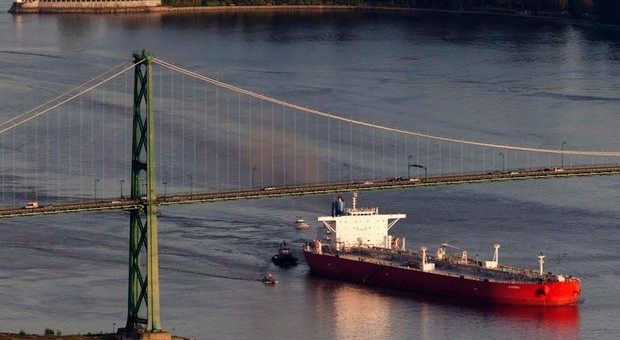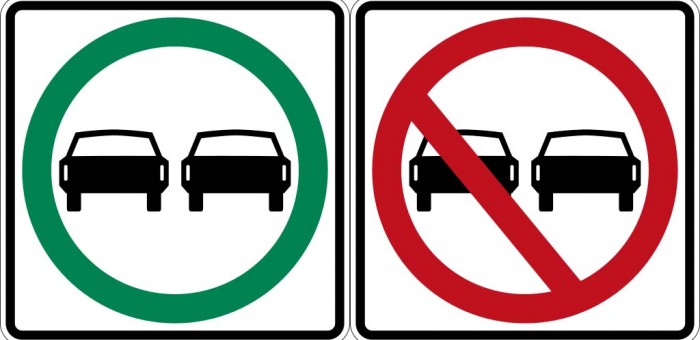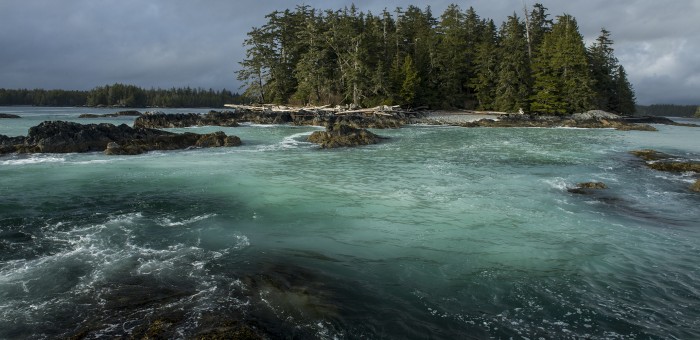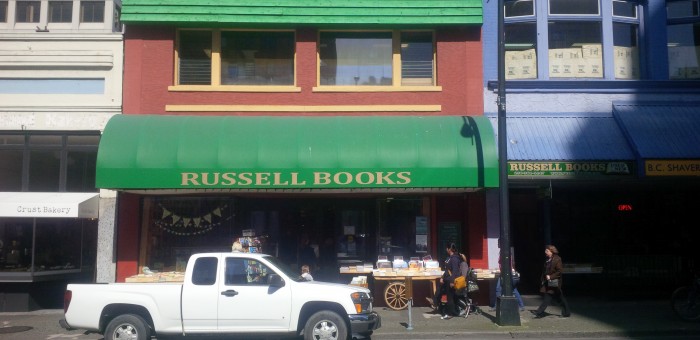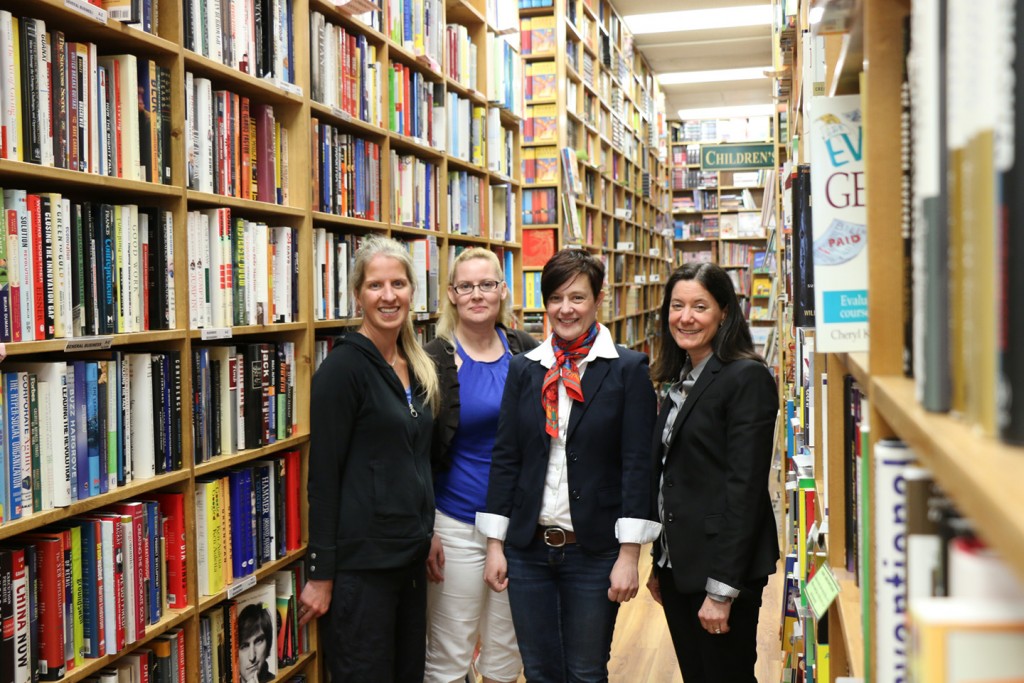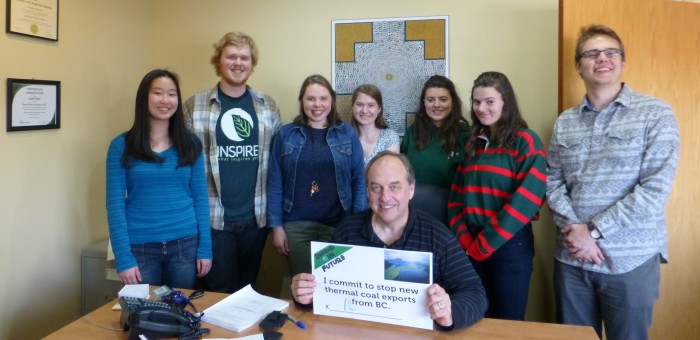Issues & Community Blog - Andrew Weaver: A Climate for Hope - Page 158
We’ve Got Lots to Learn from Vancouver’s Oil Spill
Since last weeks’ oil spill in English Bay, British Columbians living in the lower mainland and across the province have felt let down by their governments.
Despite big promises about ‘world class’ spill response, what we witnessed in English Bay proves beyond a doubt that the term ‘world class’ amounts to little more than a soundbite.
You could, however, forgive British Columbians for feeling let down for another reason. They have been watching as their politicians fall over themselves to point fingers and lay blame at their opponents’ feet.
Concerns about oil spills have been growing in B.C. ever since Enbridge’s Northern Gateway pipeline was first put forward. With Kinder Morgan’s proposed Trans Mountain pipeline routed to come straight to Vancouver harbor, those concerns have come even closer to home.
Many people are now seeing first hand how unprepared we are for a spill.
However, our lack of response capacity doesn’t come as a surprise to anyone who has been paying attention to the Kinder Morgan hearing process.
As I write this, we are in the midst of a seriously flawed National Energy Board hearing process on Kinder Morgan’s Trans Mountain pipeline. If approved, the number of oil tankers leaving Vancouver harbor would increase by 580%.
In contrast to the 2700 litres that spilled, each of these tankers would carry up to 110,000 tonnes of oil along our coastline. Unlike the bunker fuel that spilt in English Bay, which largely floats, the diluted bitumen that these tankers would carry can sink. If that happens, we currently have no way of cleaning it up.
To date, Kinder Morgan – through the hearing process – has refused to consider even the possibility of a spill larger than 15% of what a single tanker would carry. When they did simulate a spill, they applied unrealistic conditions assuming, for instance, that wave and wind conditions would be minimal and that there would be 20 hours of sunlight in August for clean-up crews. (For the record: You would have to go to Tuktayotuk on the Arctic coastline to find 20 hours of sunlight in August!).
Roughly one third of the nearly 600 questions I submitted were not adequately answered. And I’m not alone.
The Cities of Burnaby and Vancouver have been true leaders in the hearings. Together they have submitted thousands of questions to Trans Mountain and countless motions as they advocate for a better process. They too have struggled to get answers to even basic questions.
Sadly, that same leadership has been largely absent on the provincial scene.
In a process that affects all British Columbians, not a single B.C. NDP or B.C. Liberal MLA even applied to be an intervenor.
This hearing is the best opportunity MLAs have to evaluate our spill response capacity in the context of the proposed increase in oil tankers. It allows us to explore how prepared we are for a spill, and what steps are being planned to address the significant gaps.
My staff and I have poured hundreds of hours into this process, studying Trans Mountain’s application and submitting countless questions.
That is why the finger pointing is so frustrating. It is politicking with a disaster when you have played little role in actually addressing the concerns ahead of time.
The clear absence of provincial leadership in these hearings has allowed us to get to where we are today. Had more MLAs been more vocal, we may have a more rigorous hearing process.
Yet it’s not too late. I have been calling for the B.C. government to pull out of the NEB hearings and hold their own review process for some time now. The B.C. NDP and countless British Columbians have done the same. All that stands in the way is government leadership.
I hope that the spill in English Bay will spark more than just finger pointing. I hope it will serve as a wake-up call that British Columbians need to expect more from their MLAs.
They should expect us to do what’s necessary to prevent a spill from occurring in the first place – not to line up after the fact to assign blame.
Bill 15: Motor Vehicle Amendment Act
Today in the legislature I rose to speak to Bill 15: The Motor Vehicle Amendment Act. The amendments in this bill will affect the AirCare program and the Immediate Roadside Prohibition (IRP) program. It adds an official end to AirCare, which stopped running on December 31st 2014, for light duty passenger cars and trucks. For IRP it legislates mandatory participation in anti-drunk driving programs for repeat offenders (including ignition interlock systems).
Bill 15 would also make it harder for drivers to drive in the left lane of a high-speed highway, specify approved winter tires/use of chains, and allow municipalities to regulate motorcycle parking to within six metres of intersections with traffic control signs or signals.
Below is the text of my speech (note previously Leonard Krog from Nanaimo had me in stitches during his speech a few minutes earlier in the day. I continued the banter towards the end of my speech).
A. Weaver: I, too, echo the sentiments as expressed by the member for Delta South, particularly with respect to the burden of proof, which in several places in this legislation is being moved. “The burden of proof in a review of a driving prohibition” is now on the individual. This is not really consistent with what most British Columbians believe and want to happen in our province — that is, innocent until proven guilty. The implication here, of course, is guilty until proven innocent, and I wonder to what extent that actually would be held up under a legal challenge.
In fact, our Justice Minister admits that the government’s contentious drunk-driving penalties may again be challenged as unconstitutional. In the Vancouver Sun she was quoted as saying, “Yes, it may very well be challenged, but we have great confidence in the program and in the good that the program does for safety on British Columbia’s highways.” I would hope that during third reading we’ll be able to explore this and determine whether or not the Minister of Justice, via the Minister of Transportation, would be able to clarify some of the rationale behind their government getting legal opinion that would support this as actually standing up in courts.
Like the member for Nanaimo, I, too, had many, many groups of people not come to my office concerned about motorcycle parking six metres from the intersections. I gather that this is an issue in some jurisdictions. In Victoria, Oak Bay–Gordon Head, left-lane driving certainly is an issue, as every one of the members here will know, coming from either the ferries or the airport. I think left-lane driving started in Victoria and, in fact, despite this legislation, will never change here in the capital regional district.
There are rules in place already that can deal with left-lane drivers if they’re holding up traffic. I’m not sure that this emphasis on fines and fees is either enforceable or, in fact, will ever be enforceable. Our police system’s services are taxed at the best of times, and pulling over people driving in the left lane is probably not number one on their priorities.
I recognize this populist approach to introducing policy that people will hang their hat on and be all very pleased with. I know everybody at one time has been frustrated — as I was just yesterday, coming back from the airport — when two people are driving side by side on the highway at 70 kilometres an hour when the speed limit is 90. Does that mean we should be ticketing them? Does that mean we should be just maybe perhaps pulling them over and talking with them? There is legislation that would presently allow police to deal with such people if they do, in fact, believe that they are causing a hazard on the road.
One of the things that I was hoping to see in this legislation, which I recognize is minor tinkering with the Motor Vehicle Act, is some discussion about how repeat texters, repeat hand-held device users, are also dealt with. There’s a lot in here implied about drunk-driving legislation, but it really is not much different from repeat offenders of texting. There are those people out there who have been caught many times.
There are means and ways to actually have your phone linked into interlock programs, much like exist for drunk driving. I was wondering. I will explore further at third reading whether the government has actually explored this as perhaps also including interlock repeat texting offender programs. I do applaud the government in actually introducing text to ensure that the person requiring the ignition interlock program does, in fact, pay for it.
In terms of the AirCare program, you might expect someone from the B.C. Green Party to stand up here and criticize government for removing an AirCare program, but the reality of it is that cars have changed in the last decade. Most cars today on the streets have air quality emission standards that are far beyond anything that existed ten years ago. As pointed out in discussions on this legislation, there still is an ability to require people to fix their tailpipe if they are deemed to be driving a car that is creating unsightly or unhealthy air quality emissions.
With that, I do look forward to third reading. I do have some concerns with the left-lane legislation, despite the fact that I agree that it is something that people may consider. I will be likely amending that these be struck from the bill, as I believe they are awfully punitive and are unenforceable, and in fact, legislation already exists on the books to allow police to deal with this.
I believe that these left-lane-hog rules are nothing more than populist politics catering to a demographic that is perhaps not likely to consider voting in the future. This is rather cynical of me, but really, we’ve got some critical issues in this province to deal with. Motorcycle parking six metres from an intersection, left-lane driving….
I recognize that the member for Nanaimo likes the left and the Minister of Aboriginal Relations and Reconciliation likes to drive in the right. You’re not addressing my problem here. My problem is that I like to drive right in the middle in between both lanes, and this legislation ignores people like me.
L. Krog: You know what happens to chickens in the middle of the road.
A. Weaver: The member for Nanaimo has asked me if I know what happens with chickens in the middle of the road. I think it’s important for me to address that. They don’t last very long, but legislation could be brought in place to ensure that they do.
Deputy Speaker: Certainly, the member digresses.
A. Weaver: I’m sorry, hon. Speaker. It was truly, though, a defining moment of my time here in the Legislature when the Minister of Aboriginal Relations and Reconciliation came over and sat beside my colleague here, the member for Nanaimo, and discussed left- versus right-lane driving just a matter of moments ago.
With that, I thank you for your time, and I look forward to third reading.
Deputy Speaker: Seeing no further speakers, the minister closes debate.
Hon. S. Anton: I do appreciate the members’ comments on this important piece of legislation. I look forward to canvassing the issues during the committee stage. Although for the member for Oak Bay–Gordon Head, I’m not sure that we’re going to be able to deal with the middle-lane piece. But I’m confident that the other pieces of the legislation will be dealt with in an appropriate manner when the time comes.
With that, Mr. Speaker, I move second reading of Bill 15.
The Pacific Coast Herring Fishery
The long-standing Fisheries and Oceans Canada (DFO) policy to allow a Sac-Roe Fishery (SRF) harvest of herring eggs has always been incredibly wasteful and shortsighted. It is an industry that has triggered a cascading decline of economic, cultural and ecological well-being in B.C. The intensive reduction fishery started in the early 1930s and continued until all five major stocks collapsed in the late 1960s. Pacific herring populations recovered rapidly following a four year fishery closure but the species is prone to collapse and abundance has declined again recently, with little evidence of recovery. Using seine or purse nets to capture schools of pre-spawn herring, SRF boats can kill thousands of tonnes of fish in a matter of minutes. Of those huge catches, only the roe is removed for human consumption; the carcasses are treated as by-product and used to make feed tablets for fish farms, bait or put into garden fertilizers. As herring can spawn seven or eight times over their lifetime, this kill-fishery not only removes huge biomass from the overall herring population, but destroys their ability to reproduce in future years.
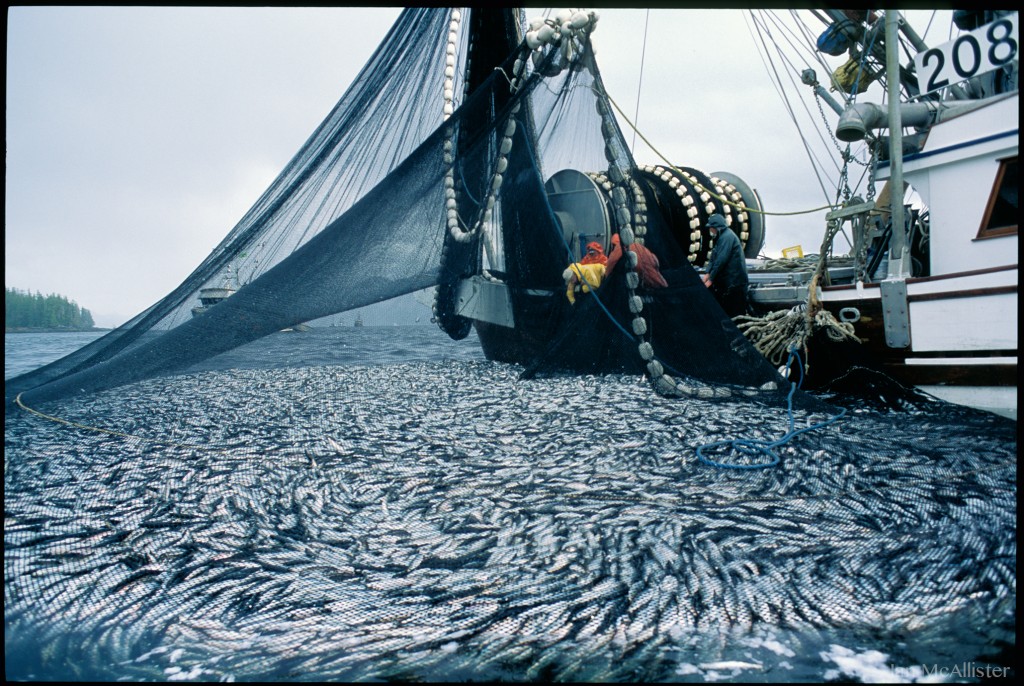 Herring captured in seine nets March 2015, photo by Ian McAllister
Herring captured in seine nets March 2015, photo by Ian McAllister
This fishery is systematically extirpating one of B.C.’s most important foundational and keystone species. Granted, there are many other wasteful industries in our country, but what makes this one so spectacularly so is the fact that there is a clear, effective, and sustainable alternative. It is not a new method of harvesting herring eggs, quite the opposite, it has been used along the B.C. coast for thousands of years. Herring bones that have been uncovered deep in the substrate of ancient village sites provides evidence of the long relationship between the first peoples of this coast and herring.
The Heiltsuk people today, like the countless generations before them, travel to the traditional herring spawning grounds in anticipation of the inshore herring migration. Heiltsuk families anchor logs and other flotation devices to the seabed and attach lines of hemlock branches or seaweed to them – essentially mimicking ideal herring spawn habitat. With luck, herring will see these branches and kelp fronds and choose them as a spawning location, after a few days multiple layers of eggs will coat the vegetation and the harvest can begin.
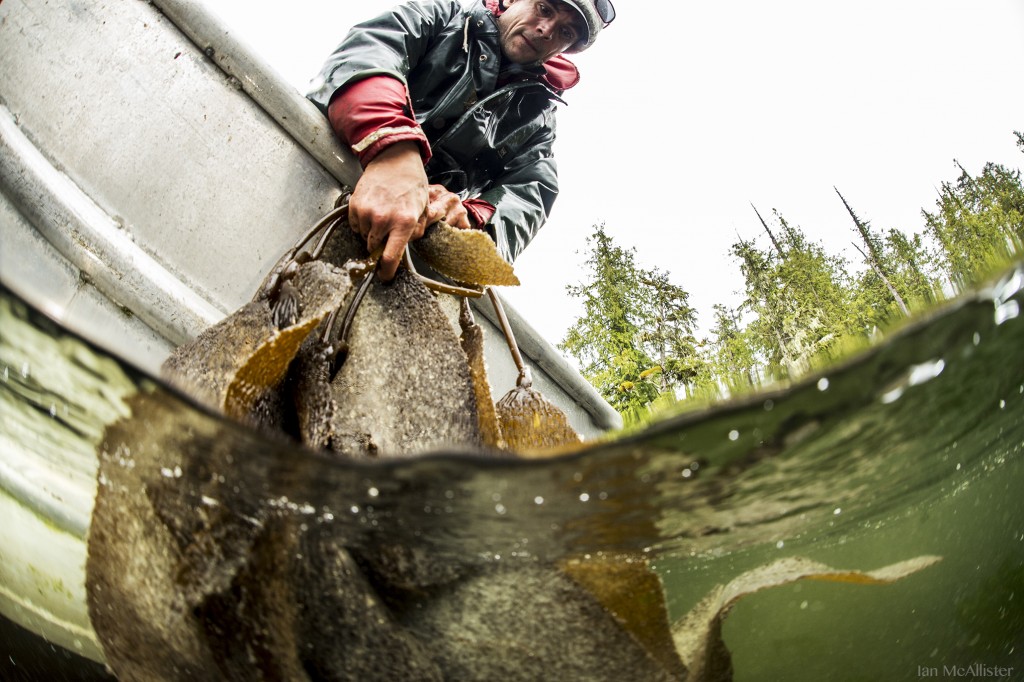 Spawn-on-kelp herring roe harvest. Kelp covered in eggs are pulled from the water on the central B.C. coast, photo by Ian McAllister
Spawn-on-kelp herring roe harvest. Kelp covered in eggs are pulled from the water on the central B.C. coast, photo by Ian McAllister
The Heiltsuk choose hemlock branches because of the needles’ flavour and medicinal benefits, but also because the natural resins provide a lot of sticky surface area for the eggs to attach themselves. Certain species of kelp are preferred over hemlock by some families, and spawn on kelp remains the main product used for export.
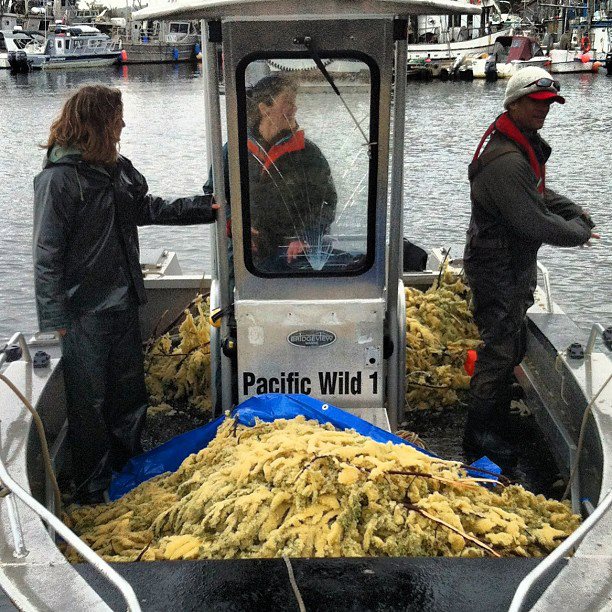 Hemlock branches coated with herring eggs, harvested near Bella Bella, B.C. Photo by Max Bakken
Hemlock branches coated with herring eggs, harvested near Bella Bella, B.C. Photo by Max Bakken
These days, as the world’s oceans are picked clean for human consumption, the words ‘sustainable fishery’ have lost their meaning. In contrast, this traditional fishery has a very small footprint. It also maximizes ecological and economic benefits as the herring get to live and continue to spawn for successive generations.
Compare this to the DFO industrial-scale kill fishery model and it becomes shameful that the Heiltsuk and other Nations have not been more supported for the long battle that they have been waging against DFO, both in the courts and by active blockades on the herring grounds – to shut this unsustainable fishery down. Like the east-coast cod and so many other fisheries that have collapsed at the hands of DFO, herring stocks here are following the same path and hundreds of traditional spawning areas in the territory have gone silent.
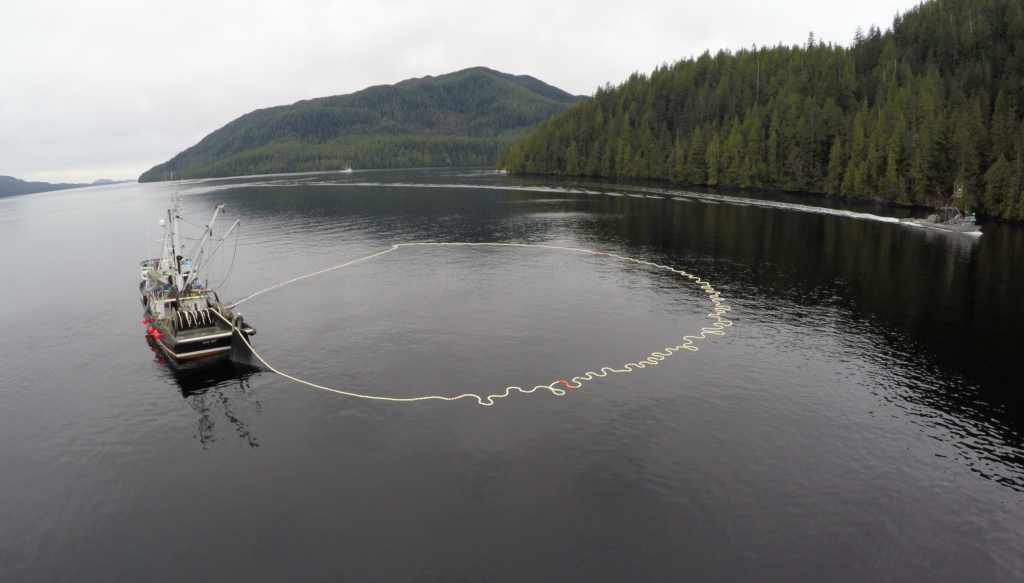 Seine nets set to harvest herring on the B.C. central coast, photo by Ian McAllister
Seine nets set to harvest herring on the B.C. central coast, photo by Ian McAllister
When the Heiltsuk fishers go out on the grounds they are bringing with them generations of experience and knowledge. The logic behind the SRF industry, however, hits a dead-end pretty quickly. One does not have to use much foresight to see that a fishery founded on the mass and unnecessary killing of future spawning populations is doomed to harvest itself into the ground. All of the hallmarks of hunter-overkill are evident with the herring fishery. More corporate control of the fishery, more technology being used with bigger boats and hi-tech sonars while the fish get smaller in size forcing more immature fish to be harvested. This not only destroys the fish with greatest lifetime spawning potential, it is not even profitable as immature fish (2-3 years old) have fragile stomach linings that burst before any roe can be harvested.
The DFO releases an annual ‘Pacific Herring Integrated Fisheries Management Plan’, which, on the surface, appears to be a comprehensive report. Reading ten years worth of these documents, however, only further convinced me that the DFO not only has a limited understanding of herring’s ecological importance, requirements, or how to safely manage them, they also don’t seem to care. Take this section of the 2004 report, for example: “At this time there is no information available on the appropriate conservation limits for the ecosystem as it pertains to the herring stocks”. It continues on to talk about harvest rates, and ends with: “Research is ongoing to better understand these ecosystem processes and the role herring plays in maintaining the integrity and functioning of the ecosystem.” This paragraph, on page two, appears sincere enough, a commitment to future herring research is definitely important. I then read the exact, word for word, statement in the 2013 report. Nine years later they have failed to do any of the conservation research they claimed to be working on, and they don’t even care enough to write a new excuse.
In 1996 conflicts between First Nations’ fishing practices and DFO’s regulations reached the Supreme Court of Canada when two Heiltsuk brothers, William and Donald Gladstone, were arrested for selling SOK. In what has become known as the Gladstone Commission, the Heiltsuk Nation argued their case and became the first Nation in Canada to be granted a court-affirmed, un-extinguished aboriginal right to commercially harvest and sell SOK. Unfortunately, this victory was not the end of the Heiltsuk Nation’s struggle with DFO. The SRF continued to kill thousands of tonnes of herring biomass every year resulting in extirpation of stocks throughout the territory.
In March, the Heiltsuk declared a tribal ban on commercial sac roe fishing in all of Area 7, including Spiller Channel, to preserve the region’s threatened herring stock. DFO opened the herring sac roe seine fishery in Spiller Channel shortly after.
“This action shows blatant disrespect of aboriginal rights by DFO and industry,” Chief Councillor Marilyn Slett told the CBC.
“DFO provided inconsistent and misleading communications throughout the day and did not attempt meaningful consultation,” said Slett.
“We must put conservation first. We have voluntarily suspended our community-owned commercial gillnet herring licenses for this season to allow stocks to rebuild, but DFO and industry are unwilling to follow suit,” said Kelly Brown, director of the Heiltsuk Integrated Resource Management Department.
In response to the situation, Fisheries and Oceans Canada told the CBC “We were committed to providing harvest opportunities where they were possible. A purse seine fishery did occur on March 22nd, yielding 690 tons of an available 800 tons. This fishery is now closed.”
The historical and ongoing treatment of herring by DFO is a tragedy. The constant theme underlying years of collapses and management failures is a complete disregard for the essential role these forage fish play in B.C.’s ecosystem and First Nations culture. Whales, dolphins, seals, sea lions, cod, salmon and sea birds all feed heavily on herring, making those small fish hugely important in the coastal ecosystem. This miraculous, mysterious species – which provides a foundation for so many – needs more support.
Banner Image: Shoreline waters change colour as the herring spawn begins in the Great Bear Rainforest, photo by Ian McAllister
Celebrating Local Businesses in Our Community – Russell Books
Building on the success of our Celebrating Youth in Our Community series, we’ve decided to initiate a series highlighting innovation and creativity within our region’s small business sector. This is the first of our series where we celebrate an innovative partnership between Russell Books and local schools.
Meeting at the sunny entrance of Russell Books, I joined the store’s manager, Andrea Minter, and very passionate group of teachers and parents to discuss their vision for inspired book fairs in Victoria schools – fairs that move beyond the corporate Scholastic model to integrate student’s interests with a small local business and sense of community. Sarah McLeod (a constituent of OBGH), the teacher-librarian at St. Margaret’s School currently doing her Master’s on the transformation of libraries to learning commons, Jennifer van Hardenberg, the communications coordinator for St. Margaret’s School, two of their Parents’ Auxiliary members, Victoria Davis and Stephanie Neilson (a constituent of OBGH), and I sat amongst great literary company in the vintage books section while they told me about the budding partnership between Russell Books and local schools.
Russell Books was started by Andrea’s grandfather, Reg Russell. He was a banker, she explained, with a book collection that outgrew his home. Andrea’s grandmother suggested he take all his books and open a small store and, in 1961, Mr. Russell did just that, starting with a 300 square foot book shop in Montreal. The store packed up and moved to Victoria in 1991 where it was run by Andrea’s parents. It has continued to expanded from its humble beginnings and now consists of 16,000 square feet of new and used books, all managed by Andrea and her husband.
Fed up with plastic book fairs that seemed designed to push stuff on their kids instead of celebrating the joy of reading, Sarah and Andrea joined forces to host their first-ever non-scholastic book fair at St. Margaret’s elementary school, building off similar fairs Andrea had hosted at Sir James Douglas where her children were students. On all levels, they said, it was a huge success. “We wanted to start slow,” Andrea said, “to make sure we were doing it right.”
“There is waste [associated with Scholastic fairs] and the books are also quite expensive,” added Sarah describing the metal boxes that would follow the shiny pamphlets to her library, chock-full of individually wrapped erasers and posters. “Russell Books provides a variety of prices [$2-20], a sense of community and warmth. It’s just a different feeling.”
70% of the books at Russell Books are used and readers can swap them back for store credit at the store once they are done, an element that provides students with a valuable lesson in sustainability and sharing.
The team working to grow and expand Russell book fairs to more schools is keen to keep kids involved. Over the past few years, the weeks leading up to their fairs are spent exchanging countless emails and phone calls about special books students are hoping will be at the fair.
“It’s all about forming connections and relationships – connecting the virtual and physical worlds found in stories, connecting schools with their community, connecting kids with books,” said Sarah.
Students have been engaged and excited about the fairs, and so have the staff at Russell Books. Before we wrapped up our meeting I asked Andrea what their capacity for expansion would be if other schools came forward interested in collaborating for their own fair, “absolutely,” she said, “we have an amazing staff here and everyone is keen to work at the book fair.” Not to mention they have over a million titles to choose from. The next fair at St. Margaret’s will be at the end of this month, coinciding with grandparent’s day.
It’s exciting to envision the potential whereby local booksellers partner with local schools to host book fairs that cater to the specific interests of our school communities. Thank you Russell Books for being an innovator in this regard.
Defend Our Future Rally at OBGH MLA Office
On April 8th, a group of well-informed and passionate young people gathered at the Oak Bay-Gordon Head MLA Constituency Office as part of the Defend Our Future BC Day of Action on Climate Change. This was one of 23 meetings organized at MLA offices in 12 cities across BC. The purpose of the meeting was for the youth to express their opposition to the expansion of thermal coal exports from BC. They voiced their concern about the Port Metro Vancouver proposal to increase exports of American thermal coal through the Fraser-Surrey Docks coal transfer facility and through the Texada Island facility by 8 million tons annually and the risk to the health and well-being of communities in proximity to rail lines, port facilities and power plants.
Each of the youth in attendance spoke about why they came to the meeting and how they expect their elected leaders to defend their future. They spoke of the need to reduce the use of thermal coal as a means of producing electricity and the need to develop renewable energy sources to mitigate global climate change. It was inspiring to hear from these young people as they led the dialogue about issues that matter to them, their future and the future for generations to come.

